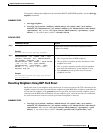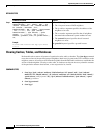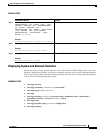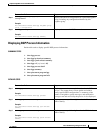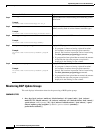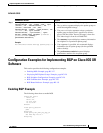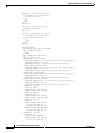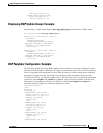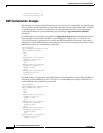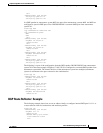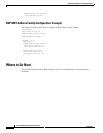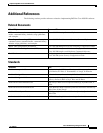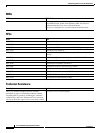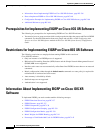
Implementing BGP on Cisco IOS XR Software
Configuration Examples for Implementing BGP on Cisco IOS XR Software
RC-129
Cisco IOS XR Routing Configuration Guide
OL-14356-01
route-policy pass-all out
address-family ipv4 multicast
route-policy pass-all in
route-policy pass-all out
Displaying BGP Update Groups: Example
The following is sample output from the show bgp update-group command run in EXEC mode:
RP/0/RP0/CPU0:router# show bgp update-group
Update group for IPv4 Unicast, index 0.1:
Attributes:
Outbound Route map:rm
Minimum advertisement interval:30
Messages formatted:2, replicated:2
Neighbors in this update group:
10.0.101.92
Update group for IPv4 Unicast, index 0.2:
Attributes:
Minimum advertisement interval:30
Messages formatted:2, replicated:2
Neighbors in this update group:
10.0.101.91
BGP Neighbor Configuration: Example
The following example shows how BGP neighbors on an autonomous system are configured to share
information. In the example, a BGP router is assigned to autonomous system 109, and two networks are
listed as originating in the autonomous system. Then the addresses of three remote routers (and their
autonomous systems) are listed. The router being configured shares information about networks
131.108.0.0 and 192.31.7.0 with the neighbor routers. The first router listed is in a different autonomous
system; the second neighbor and remote-as commands specify an internal neighbor (with the same
autonomous system number) at address 131.108.234.2; and the third neighbor and remote-as
commands specify a neighbor on a different autonomous system.
route-policy pass-all
pass
end-policy
router bgp 109
address-family ipv4 unicast
network 131.108.0.0 255.0.0.0
network 192.31.7.0 255.0.0.0
neighbor 131.108.200.1
remote-as 167
exit
address-family ipv4 unicast
route-policy pass-all in
route-policy pass-out out
neighbor 131.108.234.2
remote-as 109
exit
address-family ipv4 unicast
neighbor 150.136.64.19
remote-as 99
exit
address-family ipv4 unicast



